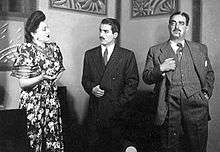Loreta (actress)
| Loreta | |
|---|---|
|
| |
| Born |
Loreta Hairapedian Tabrizi 1911[1] Tehran, Iran |
| Died |
March 29, 1998 Vienna, Austria |
| Nationality | Iranian Armenian |
| Alma mater | Moscow State University |
| Occupation | stage and film Actress |
| Spouse(s) | Abdol Hossein Noushin (1933-1972, widowed) |
| Children | Kaveh |
Loreta Hairapedian Tabrizi (Armenian: Լորետա Հայրապետեան) was an Iranian Armenian stage and film actress.

Biography
Loreta was born as Loreta Hairapedian Tabrizi in 1911 in Tehran. Following a succession of roles in performances of William Shakespeare directed by Vahram Arsen Papazian, she married the well-known stage director Abdol Hossein Noushin and joined the Iran Club of Theater. There, she appeared in grand scale performances of such plays as Othello, Volpone, The Blue Bird and Gas Light. In 1933, she married Abdol Hossein Noushin.[2] In 1953 Loreta traveled abroad together with her husband following the 1953 coup d'etát, and the couple lived in Moscow for several years, where they both entered education; Loreta entered the acting school of the Moscow State University (Moscow Art Theatre), while her husband studied for a PhD in philology at the Maxim Gorky Literature Institute.[3] When the couple returned to Iran after several years, Loreta broke into films and made six films the first of which was The Night of Execution (Davoud Mollapour, 1970). The list includes the co-production Bride of Fortune and Ebrahim Golestan's The Mystery of The Treasure of The Valley of The Genies al well. Her only TV series was Khosrov-Mirza II (Nosrat Karimi). Loreta left Iran in 1979 together with her only son from her marriage with Noushin,[4] and went to live in Vienna, Austria, where she died on 29 March 1998.[5][6][7][8]
Filmography
- 1972 The Triple Bed
- 1974 Asrar ganj dareheye jenni
Television
- 1977 Khosrow Mirza-ye dovom (TV Mini-Series)
References
- ↑ Cronin, Stephanie (2013). Iranian-Russian Encounters: Empires and Revolutions Since 1800. Routledge. p. 346. ISBN 978-0415624336.
- ↑ Cronin, Stephanie (2013). Iranian-Russian Encounters: Empires and Revolutions Since 1800. Routledge. p. 346. ISBN 978-0415624336.
- ↑ Cronin, Stephanie (2013). Iranian-Russian Encounters: Empires and Revolutions Since 1800. Routledge. p. 355. ISBN 978-0415624336.
- ↑ Milani, Abbas (2008). Eminent Persians, Volume 1. Syracuse University Press. p. 1008. ISBN 978-0815609070.
- ↑ Armenians And Iranian Cinema. Tehran: Film Museum Of Iran. Summer 2004. p. 86. ISBN 964-6728-44-8.
- ↑ Janet D. Lazarian (2003). Encyclopedia of Iranian Armenians. Tehran: Hirmand Publisher. pp. 431–32. ISBN 964-6974-50-3.
- ↑ "Iranian Movie DataBase لرتا هايراپتيان تبريزي". sourehcinema. Retrieved 28 December 2015.
- ↑ Andranik Hovian (2002). Iranian Armenians. Tehran: Center for International Cultura. ISBN 9643630072.
External links
- Loreta at the Internet Movie Database